Through ‘Fisher’s Right to Know,’ filmmaker John Haley hopes to foster care and concern for environment
 Among the environmentally-themed films that the Fort Myers Film Festival will screen this year is John Haley’s A Fisher’s Right to Know.
Among the environmentally-themed films that the Fort Myers Film Festival will screen this year is John Haley’s A Fisher’s Right to Know.
Fishers throughout East Alabama depend on the mighty Coosa River for food, recreation and a family pastime that goes back generations. But do fishermen and women — and their families — have a right to know 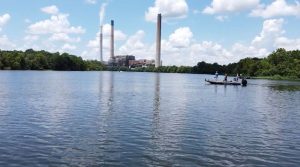 which fish are safe to consume? Not currently in Alabama, the River State. Coosa Riverkeeper and other advocates are working to give fishers across the entire state that right.
which fish are safe to consume? Not currently in Alabama, the River State. Coosa Riverkeeper and other advocates are working to give fishers across the entire state that right.
Coosa Riverkeeper is a citizen-based nonprofit that was founded in 2010 by a group of environmental leaders in the  Coosa Valley of Alabama in response to the river being listed as the 10th most endangered river in the United States by American Rivers. From humble beginnings in a small mini-storage warehouse office in Riverside on the banks of Logan Martin Lake, the organization has grown to three full-time staff,
Coosa Valley of Alabama in response to the river being listed as the 10th most endangered river in the United States by American Rivers. From humble beginnings in a small mini-storage warehouse office in Riverside on the banks of Logan Martin Lake, the organization has grown to three full-time staff, 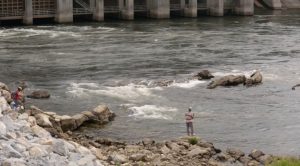 dozens of interns, a Board of Directors, an Advisory Council, dozens of volunteers and interns and hundreds of members. Its mission is to protect, restore and promote the Coosa River and its tributaries. Toward this end, its teams test water quality every summer at popular swim holes
dozens of interns, a Board of Directors, an Advisory Council, dozens of volunteers and interns and hundreds of members. Its mission is to protect, restore and promote the Coosa River and its tributaries. Toward this end, its teams test water quality every summer at popular swim holes 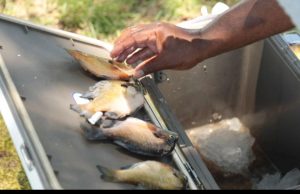 along the Coosa and publish a Swim Guide that contains water quality alerts. But it’s their Fish Guide that lies at the heart of A Fisher’s Right to Know.
along the Coosa and publish a Swim Guide that contains water quality alerts. But it’s their Fish Guide that lies at the heart of A Fisher’s Right to Know.
According to EPA data analyzed by Coosa Riverkeeper, more than 1.5 million pounds of toxic chemicals were dumped into the Coosa River in 2017,  necessitating the issuance of dozens of fish consumption advisories for PCBs and mercury, two industrial pollutants.
necessitating the issuance of dozens of fish consumption advisories for PCBs and mercury, two industrial pollutants.
At least two industries, National Cement Company in Ragland and Lhoist North America in Calera, reported discharging mercury to streams in the Coosa Valley in 2015.  Others, including the Gaston Steam Plant in Wilsonville discharged mercury to the atmosphere which may ultimately end up in waterways. In total, 17 facilities in Alabama reported discharging mercury to waterways in 2015. Mercury accumulates in fish to such great extents that it can pose a risk
Others, including the Gaston Steam Plant in Wilsonville discharged mercury to the atmosphere which may ultimately end up in waterways. In total, 17 facilities in Alabama reported discharging mercury to waterways in 2015. Mercury accumulates in fish to such great extents that it can pose a risk 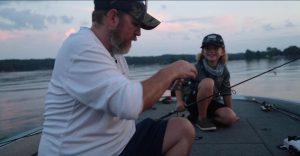 of illness to humans who eat their catch. That notwithstanding, the discharge of these chemicals is legally authorized and permitted by the Alabama Department of Environmental Management through their National Pollution Discharge Elimination System.
of illness to humans who eat their catch. That notwithstanding, the discharge of these chemicals is legally authorized and permitted by the Alabama Department of Environmental Management through their National Pollution Discharge Elimination System.
But 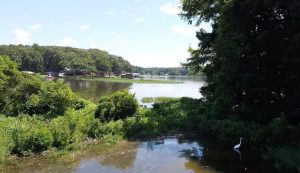 mercury is not the only harmful chemical being discharged into the Coosa and other Alabama bodies of water. Two chicken processing plants near Gadsden owned by Koch Foods, Alabama Power Company’s Gaston Steam Plant in Wilsonville and Resolute Forest Products Coosa Pines paper mill dump nitrates (which are harmful to children and
mercury is not the only harmful chemical being discharged into the Coosa and other Alabama bodies of water. Two chicken processing plants near Gadsden owned by Koch Foods, Alabama Power Company’s Gaston Steam Plant in Wilsonville and Resolute Forest Products Coosa Pines paper mill dump nitrates (which are harmful to children and livestock), PCBs and other cancer-causing chemicals.
livestock), PCBs and other cancer-causing chemicals.
To alert both commercial fishers and unsuspecting pleasure anglers to these dangers, Coosa Riverkeeper provides an interactive map that lets users know where Fish Consumption Advisories 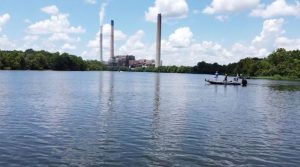 have been issued.
have been issued.
“Even though this information is publicly available, the government makes little to no effort to inform the public about theses toxic chemicals in our waterways,” states Riverkeeper Steven Dudley. “People have the right to know what’s in the water they drink and in 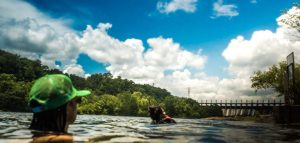 which they fish and swim.”
which they fish and swim.”
“While collaborating with the folks at Coosa Riverkeeper as well as politicians, activists, and fishers across Alabama to create this film, I came to understand how everyone involved 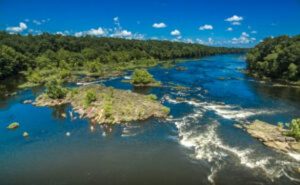 in this project believed that this film could be a vehicle for fostering care and concern for the environment not only in Alabama but in communities across the country,” states filmmaker John Haley. “FMFF represents a valuable opportunity to expand the audience for this deeply important narrative, carrying with it the
in this project believed that this film could be a vehicle for fostering care and concern for the environment not only in Alabama but in communities across the country,” states filmmaker John Haley. “FMFF represents a valuable opportunity to expand the audience for this deeply important narrative, carrying with it the 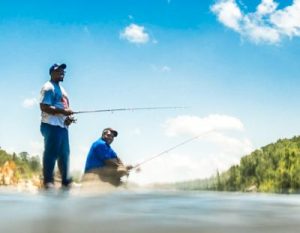 possibility to further encourage localized efforts for environmental safety and protection while fostering dialogue about how we can hold governments and industries accountable to ensure the safety of our waters.”
possibility to further encourage localized efforts for environmental safety and protection while fostering dialogue about how we can hold governments and industries accountable to ensure the safety of our waters.”
In 2006, America Rivers rated the Caloosahatchee as the 7th most endangered river is the country. It is still impaired 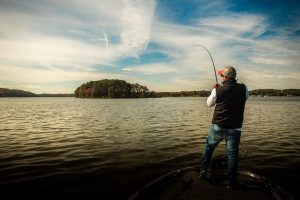 according to the Florida Department of Environmental Protection’s (FDEP) implementation of the Impaired Waters Rule (IWR). Like most waterways and lakes within the state, the Caloosahatchee suffers from mercury impairment which prompts the issuance of Florida Fish Consumption Advisories by the Department of Health to provide guidance on how to limit mercury exposure from fish
according to the Florida Department of Environmental Protection’s (FDEP) implementation of the Impaired Waters Rule (IWR). Like most waterways and lakes within the state, the Caloosahatchee suffers from mercury impairment which prompts the issuance of Florida Fish Consumption Advisories by the Department of Health to provide guidance on how to limit mercury exposure from fish  caught in the Caloosahatchee and its estuaries. Increased rates of childhood leukemia and other cancers has also been linked to the river, whose water quality is chronically compromised by the U.S. Army Corps of Engineers discharging an average of 1.3 billion gallons of water from Lake Okeechobee into the spillways at the river’s headwaters (compared to just 430 million gallons of lake water being sent south into stormwater treatment areas.
caught in the Caloosahatchee and its estuaries. Increased rates of childhood leukemia and other cancers has also been linked to the river, whose water quality is chronically compromised by the U.S. Army Corps of Engineers discharging an average of 1.3 billion gallons of water from Lake Okeechobee into the spillways at the river’s headwaters (compared to just 430 million gallons of lake water being sent south into stormwater treatment areas.
“We’re looking at this being a long-term thing,” Florida commander 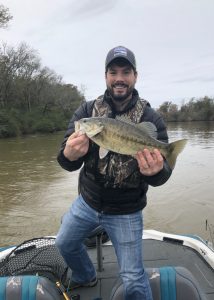 Col. Andrew Kelly said as recently as March 11, 2021. The Corps is seeking to reduce the water level in Lake O to 12 feet 5 inches by June 1 in order to make room for summer rains and tropical rainfall.
Col. Andrew Kelly said as recently as March 11, 2021. The Corps is seeking to reduce the water level in Lake O to 12 feet 5 inches by June 1 in order to make room for summer rains and tropical rainfall.
A Fisher’s Right to Know screens at three separate locations during FMFF. It will screen first in the Sidney & Berne Davis Art Center during Environmental Block 2 at 3:00 p.m. on Friday, May 14 (along with Marjory, Barbara Crites: Snorkeling St. John USVI, Stay Wild and Soiled). It screens four hours later at the Alliance for the Arts beginning at 7:00 p.m. (along with Fight to Save Two National Treasures). And it will screen at various times at the IMAG History & Science Center all day on Saturday, May 15 (along with This Other World, Underwater Senses, The Wild Divide and Barbara Crities: Snorkeling St. John USVI).
April 26, 2021.














 Tom Hall is both an amateur artist and aspiring novelist who writes art quest thrillers. He is in the final stages of completing his debut novel titled "Art Detective," a story that fictionalizes the discovery of the fabled billion-dollar Impressionist collection of Parisian art dealer Josse Bernheim-Jeune, thought by many to have perished during World War II when the collection's hiding place, Castle de Rastignac in southern France, was destroyed by the Wehrmacht in reprisal for attacks made by members of the Resistance operating in the area. A former tax attorney, Tom holds a bachelor's degree as well as both a juris doctorate and masters of laws in taxation from the University of Florida. Tom lives in Estero, Florida with his fiancee, Connie, and their four cats.
Tom Hall is both an amateur artist and aspiring novelist who writes art quest thrillers. He is in the final stages of completing his debut novel titled "Art Detective," a story that fictionalizes the discovery of the fabled billion-dollar Impressionist collection of Parisian art dealer Josse Bernheim-Jeune, thought by many to have perished during World War II when the collection's hiding place, Castle de Rastignac in southern France, was destroyed by the Wehrmacht in reprisal for attacks made by members of the Resistance operating in the area. A former tax attorney, Tom holds a bachelor's degree as well as both a juris doctorate and masters of laws in taxation from the University of Florida. Tom lives in Estero, Florida with his fiancee, Connie, and their four cats.